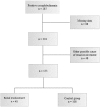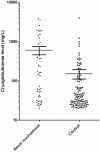Predictive factors of renal involvement in cryoglobulinaemia: a retrospective study of 153 patients
- PMID: 31198536
- PMCID: PMC6543974
- DOI: 10.1093/ckj/sfy096
Predictive factors of renal involvement in cryoglobulinaemia: a retrospective study of 153 patients
Abstract
Background: The course of cryoglobulinaemia varies widely, from asymptomatic patients to severe vasculitis syndrome. Renal involvement (RI) is the major prognostic factor, and frequently occurs several years after diagnosis. However, predictive factors for RI are not well known. The aim of our study was to identify RI predictive factors during cryoglobulinaemia.
Methods: We retrospectively reviewed the clinical charts of a consecutive series of 153 patients positive for cryoglobulinaemia in the University Hospital of Lyon (France). RI was defined either histologically or biologically if cryoglobulinaemia was the only possible cause of nephropathy.
Results: Among the 153 positive patients (mean age 55 years, 37% male), cryoglobulinaemia was associated with RI in 45 (29%) patients. Sixty-five percent of patients had Type II cryoglobulinaemia, 28% had Type III and 7% had Type I. Autoimmune diseases were the most common aetiology (48%), followed by infectious diseases (18%) and lymphoproliferative disorders (13%). Membranoproliferative glomerulonephritis was the main histological pattern (93% of the 14 histological analyses). A multivariable logistic regression showed that Type II cryoglobulinaemia, a high serum cryoglobulin concentration, the presence of an IgG kappa monoclonal component and diabetes were independently associated with the risk for developing RI.
Conclusion: We identified several factors predictive of RI in patients with cryoglobulinaemia, which were different from the diagnostic criteria for cryoglobulinaemic vasculitis. This could suggest a specific pathophysiology for RI. We suggest performing an extensive renal monitoring and ensure nephroprotection when a diagnosis of cryoglobulinaemia is made in patients with these predictive factors.
Keywords: cryoglobulinaemia; kidney failure; predictive factors; proteinuria; renal involvement.
Figures
Similar articles
-
Clinical and morphologic spectrum of renal involvement in patients with HBV-associated cryoglobulinaemia.Nephrology (Carlton). 2017 Jun;22(6):449-455. doi: 10.1111/nep.12795. Nephrology (Carlton). 2017. PMID: 27062412
-
Cryoglobulinaemia.Nat Rev Dis Primers. 2018 Aug 2;4(1):11. doi: 10.1038/s41572-018-0009-4. Nat Rev Dis Primers. 2018. PMID: 30072738 Review.
-
Effects of long-term course of alpha-interferon in patients with chronic hepatitis C associated to mixed cryoglobulinaemia.Eur J Gastroenterol Hepatol. 1997 Nov;9(11):1067-72. doi: 10.1097/00042737-199711000-00008. Eur J Gastroenterol Hepatol. 1997. PMID: 9431896 Clinical Trial.
-
[Instructions and implementations for percutaneous renal biopsy. Guidelines for the therapy of glomerular nephropaties].G Ital Nefrol. 2003 Sep-Oct;20 Suppl 24:S3-47. G Ital Nefrol. 2003. PMID: 14666502 Review. Italian.
-
Type II essential mixed cryoglobulinaemia: presentation, treatment and outcome in 13 patients.Q J Med. 1992 Feb;82(298):101-24. Q J Med. 1992. PMID: 1620812
Cited by
-
Noninfectious, Severe Cryoglobulinemic Vasculitis with Renal Involvement - Safety and Efficacy of Long-Term Treatment with Rituximab.Int J Nephrol Renovasc Dis. 2021 Jul 16;14:267-277. doi: 10.2147/IJNRD.S315388. eCollection 2021. Int J Nephrol Renovasc Dis. 2021. PMID: 34295176 Free PMC article.
-
Understanding the Cryoglobulinemias.Curr Rheumatol Rep. 2019 Nov 19;21(11):60. doi: 10.1007/s11926-019-0859-0. Curr Rheumatol Rep. 2019. PMID: 31741077 Review.
-
Persistence of Cryoglobulinemic Vasculitis after DAA Induced HCV Cure.J Clin Med. 2022 Feb 14;11(4):984. doi: 10.3390/jcm11040984. J Clin Med. 2022. PMID: 35207257 Free PMC article. Review.
-
Renal Involvement in Mixed Cryoglobulinemic Vasculitis: Current Perspectives.J Clin Med. 2025 Jun 19;14(12):4369. doi: 10.3390/jcm14124369. J Clin Med. 2025. PMID: 40566113 Free PMC article. Review.
-
Proteomic Profiling of Cryoglobulinemia.Front Immunol. 2022 May 23;13:855513. doi: 10.3389/fimmu.2022.855513. eCollection 2022. Front Immunol. 2022. PMID: 35677050 Free PMC article.
References
-
- Ramos-Casals M, Stone JH, Cid MC. et al. The cryoglobulinaemias. Lancet 2012; 379: 348–360 - PubMed
-
- Brouet J-C, Clauvel J-P, Danon F. et al. Biologic and clinical significance of cryoglobulins. Am J Med 1974; 57: 775–788 - PubMed
-
- Retamozo S, Brito-Zerón P, Bosch X. et al. Cryoglobulinemic disease. Oncol (Williston Park) 2013; 27: 1098–1105, 1110–1116 - PubMed
LinkOut - more resources
Full Text Sources



